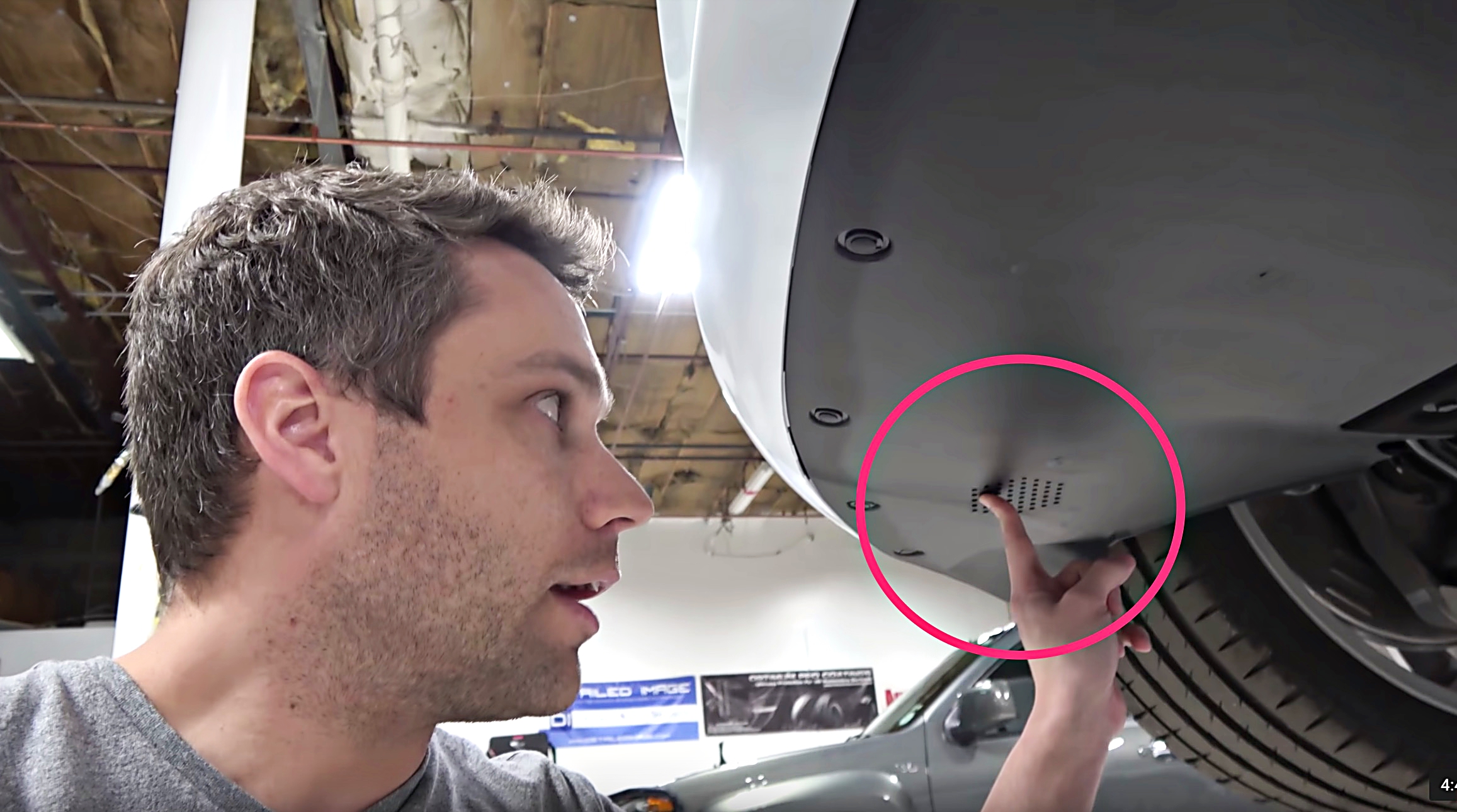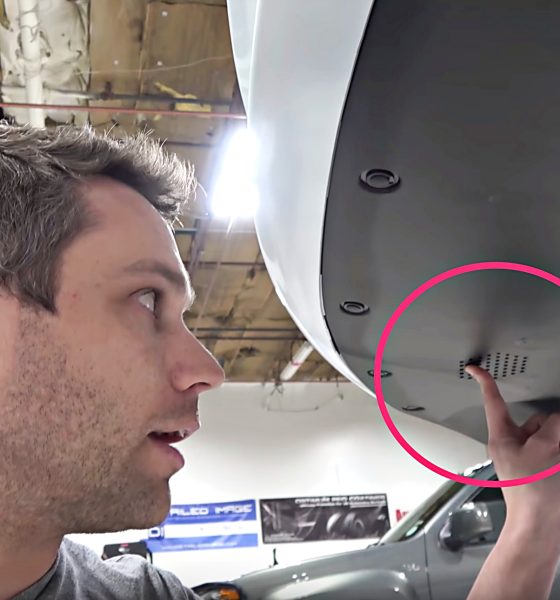

News
Tesla Model 3 spotted with “pedestrian noise maker” ahead of NHTSA mandate
It looks like Tesla may have already begun getting its newer manufactured vehicles ready for compliance with an upcoming National Highway Traffic Safety Administration (NHTSA) requirement for electric and hybrid electric vehicles to make noise when traveling at slow speeds. In a video posted by Tesla community’s resident DIY expert, Erik, or otherwise known as DÆrik from his YouTube channel, the undercarriage panel of his Performance Model 3 has what appears to be a speaker grill – the front paneling is adorned with a series of holes in a hexagonal shape. Once the paneling is removed, three mounting points are revealed to be molded into the same area, hinting at a future device to come.
The video was made in response to inquiries about a photo of the Tesla’s undercarriage posted to Erik’s Instagram account where someone noted the series of holes in the plastic panel below the front bumper. Tesla’s parts catalog doesn’t currently show the grill cutout, but As Erik notes in the video, he found a Model S diagram three years ago showing a layout including a future noise maker labeled “Speaker Pedestrian Noise”.
We’ve reached out to Tesla for comment about the new “speaker grill” found in the underside of the Model 3 and will provide updates as we receive them.
https://www.instagram.com/p/BsYwz0ygTB5/
Blind pedestrians rely heavily on auditory clues to anticipate traffic patterns and know a vehicle is near, and that means the quiet nature of electric and hybrid vehicles at low speeds may pose a greater danger to them than traditional internal combustion engine (ICE) vehicles. Bicyclists and other pedestrians also utilize usual car sounds as part of their personal safety awareness, so there’s a population of travelers that could be significantly impacted by the influx of EV/HEV vehicles on the roads. The potential danger has not gone unnoticed by those in charge of public safety.
This concern was elevated to the federal level by the NHTSA, and the eventual result was a 2010 law (Pedestrian Safety Enhancement Act of 2010) requiring electric and hybrid vehicle manufacturers to install devices which emit noise while traveling slower than about 19 mph. Higher speeds have tire and wind noise that’s sufficient for pedestrian needs. The implementation rules were finalized in February last year, and manufacturers have until September 1, 2020, to be fully compliant, with half of the vehicles equipped by September 1, 2019.
While the proposal may not be popular with all parties involved, the NHTSA points to its October 2009 report entitled “Research on Quieter Cars and the Safety of Blind Pedestrians, a Report to Congress” as a primary basis for its rulemaking. In the report, the agency found an increased rate of accidents involving pedestrians with hybrid-electric vehicles compared to ICE vehicles in roadways and zones with low-speed limits, during the type of weather or any time of day. By implementing the rules as passed, the NHTSA expects to prevent 2,400 injuries and reduce the $250-$320 million costs which result annually due to limited ability to detect quiet EVs/HEVs.
POPULAR: DIY Tesla Model S Pedestrian Alert: “Horn” for the Oblivious
Another coming requirement is that the noise emitted must be identifiable as a vehicle, a limitation that will likely only inspire creativity. If manufacturers want to take a fun route with the noise options, i.e, license the Jetson family’s flying car sound from Hanna Barbara as suggested by Erik, they’ll have to make sure it’s consistent among their vehicles – or at least consistent among package options. Also, drivers cannot be allowed to modify the sound themselves.
Manufacturers are free to modify the sounds from the factory end, though, an option Tesla’s CEO Elon Musk has previously capitalized on for other noise-centric features in the electric car company’s vehicles. However, letting drivers determine their car’s noise via app or button push is still in the air. The NHTSA will publish a separate document at a later date to determine whether driver-selectable sounds are a good idea, or at least compliant with the purpose of the law.
Watch the video below to see Erik’s Model 3 inspection:

News
Tesla FSD fleet is nearing 7 billion total miles, including 2.5 billion city miles
As can be seen on Tesla’s official FSD webpage, vehicles equipped with the system have now navigated over 6.99 billion miles.

Tesla’s Full Self-Driving (Supervised) fleet is closing in on almost 7 billion total miles driven, as per data posted by the company on its official FSD webpage.
These figures hint at the massive scale of data fueling Tesla’s rapid FSD improvements, which have been quite notable as of late.
FSD mileage milestones
As can be seen on Tesla’s official FSD webpage, vehicles equipped with the system have now navigated over 6.99 billion miles. Tesla owner and avid FSD tester Whole Mars Catalog also shared a screenshot indicating that from the nearly 7 billion miles traveled by the FSD fleet, more than 2.5 billion miles were driven inside cities.
City miles are particularly valuable for complex urban scenarios like unprotected turns, pedestrian interactions, and traffic lights. This is also the difference-maker for FSD, as only complex solutions, such as Waymo’s self-driving taxis, operate similarly on inner-city streets. And even then, incidents such as the San Francisco blackouts have proven challenging for sensor-rich vehicles like Waymos.
Tesla’s data edge
Tesla has a number of advantages in the autonomous vehicle sector, one of which is the size of its fleet and the number of vehicles training FSD on real-world roads. Tesla’s nearly 7 billion FSD miles then allow the company to roll out updates that make its vehicles behave like they are being driven by experienced drivers, even if they are operating on their own.
So notable are Tesla’s improvements to FSD that NVIDIA Director of Robotics Jim Fan, after experiencing FSD v14, noted that the system is the first AI that passes what he described as a “Physical Turing Test.”
“Despite knowing exactly how robot learning works, I still find it magical watching the steering wheel turn by itself. First it feels surreal, next it becomes routine. Then, like the smartphone, taking it away actively hurts. This is how humanity gets rewired and glued to god-like technologies,” Fan wrote in a post on X.
News
Tesla starts showing how FSD will change lives in Europe
Local officials tested the system on narrow country roads and were impressed by FSD’s smooth, human-like driving, with some calling the service a game-changer for everyday life in areas that are far from urban centers.

Tesla has launched Europe’s first public shuttle service using Full Self-Driving (Supervised) in the rural Eifelkreis Bitburg-Prüm region of Germany, demonstrating how the technology can restore independence and mobility for people who struggle with limited transport options.
Local officials tested the system on narrow country roads and were impressed by FSD’s smooth, human-like driving, with some calling the service a game-changer for everyday life in areas that are far from urban centers.
Officials see real impact on rural residents
Arzfeld Mayor Johannes Kuhl and District Administrator Andreas Kruppert personally tested the Tesla shuttle service. This allowed them to see just how well FSD navigated winding lanes and rural roads confidently. Kruppert said, “Autonomous driving sounds like science fiction to many, but we simply see here that it works totally well in rural regions too.” Kuhl, for his part, also noted that FSD “feels like a very experienced driver.”
The pilot complements the area’s “Citizen Bus” program, which provides on-demand rides for elderly residents who can no longer drive themselves. Tesla Europe shared a video of a demonstration of the service, highlighting how FSD gives people their freedom back, even in places where public transport is not as prevalent.
What the Ministry for Economic Affairs and Transport says
Rhineland-Palatinate’s Minister Daniela Schmitt supported the project, praising the collaboration that made this “first of its kind in Europe” possible. As per the ministry, the rural rollout for the service shows FSD’s potential beyond major cities, and it delivers tangible benefits like grocery runs, doctor visits, and social connections for isolated residents.
“Reliable and flexible mobility is especially vital in rural areas. With the launch of a shuttle service using self-driving vehicles (FSD supervised) by Tesla in the Eifelkreis Bitburg-Prüm, an innovative pilot project is now getting underway that complements local community bus services. It is the first project of its kind in Europe.
“The result is a real gain for rural mobility: greater accessibility, more flexibility and tangible benefits for everyday life. A strong signal for innovation, cooperation and future-oriented mobility beyond urban centers,” the ministry wrote in a LinkedIn post.
News
Tesla China quietly posts Robotaxi-related job listing
Tesla China is currently seeking a Low Voltage Electrical Engineer to work on circuit board design for the company’s autonomous vehicles.

Tesla has posted a new job listing in Shanghai explicitly tied to its Robotaxi program, fueling speculation that the company is preparing to launch its dedicated autonomous ride-hailing service in China.
As noted in the listing, Tesla China is currently seeking a Low Voltage Electrical Engineer to work on circuit board design for the company’s autonomous vehicles.
Robotaxi-specific role
The listing, which was shared on social media platform X by industry watcher @tslaming, suggested that Tesla China is looking to fill the role urgently. The job listing itself specifically mentions that the person hired for the role will be working on the Low Voltage Hardware team, which would design the circuit boards that would serve as the nervous system of the Robotaxi.
Key tasks for the role, as indicated in the job listing, include collaboration with PCB layout, firmware, mechanical, program management, and validation teams, among other responsibilities. The role is based in Shanghai.
China Robotaxi launch
China represents a massive potential market for robotaxis, with its dense urban centers and supportive policies in select cities. Tesla has limited permission to roll out FSD in the country, though despite this, its vehicles have been hailed as among the best in the market when it comes to autonomous features. So far, at least, it appears that China supports Tesla’s FSD and Robotaxi rollout.
This was hinted at in November, when Tesla brought the Cybercab to the 8th China International Import Expo (CIIE) in Shanghai, marking the first time that the autonomous two-seater was brought to the Asia-Pacific region. The vehicle, despite not having a release date in China, received a significant amount of interest among the event’s attendees.








